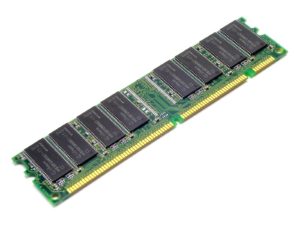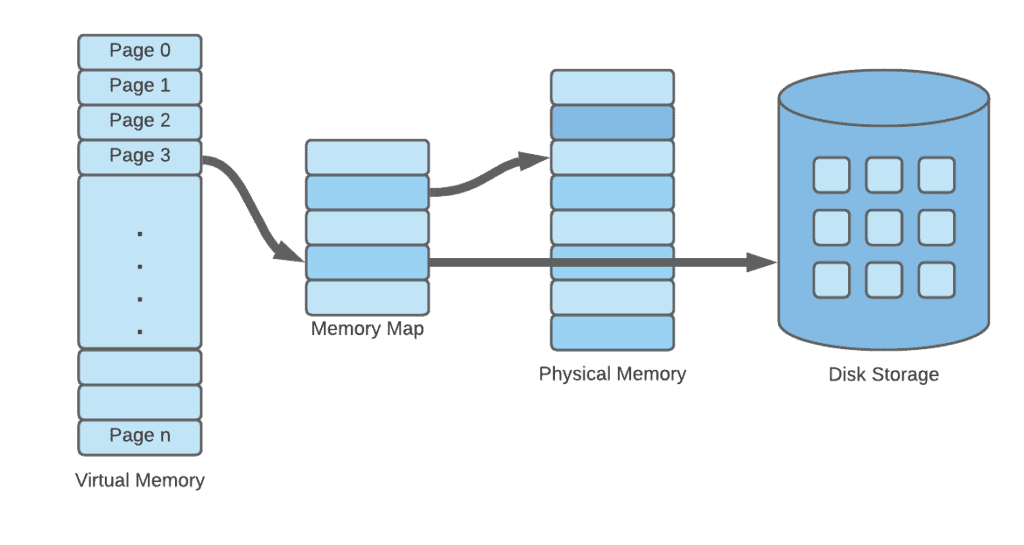1. 简介
本文将简明扼要地介绍物理内存(Physical Memory)与虚拟内存(Virtual Memory)的基本概念。随后会对虚拟内存的工作机制做简要说明,最后总结它们之间的主要区别。
对于有经验的开发者来说,理解这两者之间的差异和协同机制,有助于更好地进行性能调优、资源管理和问题排查。尤其在 JVM 内存管理、系统性能瓶颈分析等场景中,这些知识尤为重要。
2. 物理内存
物理内存,也称为主存(Primary Memory),是 CPU 可以直接访问的存储空间。早期的计算机使用延迟线、Williams-Kilburn 管或旋转磁鼓等技术实现主存。到了 20 世纪 50 年代,磁芯内存逐步取代了这些不可靠的方案。直到 70 年代磁芯内存仍被广泛使用。随着集成电路(IC)技术的进步,半导体内存逐渐取代磁芯内存,成为主流。
✅ 现在我们所说的物理内存,其实就是计算机主板上的 RAM(Random Access Memory)。它是一种易失性存储器,断电后数据会丢失。
物理内存的特点如下:
- 容量受限于 RAM 芯片大小
- 访问速度快,适合 CPU 直接读写
- 数据线性排列,地址递增
- 程序指令和数据都存储在其中
- 需要持续供电,否则数据会丢失
下图展示了一个常见的物理内存条(RAM):

程序通常存储在硬盘上。如果 CPU 每次执行程序都要从硬盘读取,效率会非常低。因此,物理内存的作用就是缓存这些程序和数据,让 CPU 能够快速访问。
✅ 物理内存的访问速度远快于硬盘,因此程序运行时会被加载到内存中执行。执行结束后,程序数据会返回硬盘。如果有新的程序需要运行,它会使用当前空闲的内存空间。我们把运行中的程序称为进程(Process)。
3. 虚拟内存
如前所述,RAM 这类物理内存容量有限且价格昂贵。相比之下,硬盘这类二级存储成本低、容量大,也更容易扩展。
虚拟内存是一种内存管理策略,它为用户呈现出一个“看起来很大”的内存空间。通过虚拟内存机制,操作系统可以将一部分物理内存的内容临时交换到硬盘上,从而让程序感觉自己拥有比实际物理内存大得多的可用内存。
✅ 虚拟内存的核心思想是:通过操作系统和硬件的配合,将部分内存数据移到磁盘,从而扩展可用内存空间。
虚拟内存的工作流程如下图所示:

3.1. 虚拟内存的位置
虚拟内存以“页(Page)”的形式存在。页是内存管理的基本单位,一个页通常为 4KB。程序可以非常大,但并非所有部分都需要加载到物理内存中。只有当前需要执行的部分才会被加载。
举个例子:你在玩 GTA 这类大型游戏时,游戏文件是安装在硬盘上的。但并不是整个游戏都会加载到 RAM 中,只有当前运行所需的部分才会被加载到内存中。
3.2. 虚拟内存的工作原理
虚拟内存的实现依赖于软硬件协同工作。操作系统和 CPU 中的内存管理单元(MMU)共同负责将虚拟地址(Virtual Address)转换为物理地址(Physical Address)。
在操作系统中,我们看到的是逻辑地址。系统会在加载、执行或编译时动态地将这些地址转换为物理地址。这种机制使得内存的使用更加灵活高效。
⚠️ 实际运行中,进程在内存中的分布并不是连续的。系统会将其拆分成多个页,分散存储在物理内存中。这种机制通过动态运行时地址转换和页表(Page Table)来实现。
4. 物理内存 vs 虚拟内存对比
| 对比维度 | 物理内存 | 虚拟内存 |
|---|---|---|
| 定义 | 实际的 RAM | 内存管理技术 |
| 实现方式 | 使用交换(Swapping) | 使用分页(Paging) |
| CPU 访问能力 | 可以直接访问 | 无法直接访问 |
| 容量限制 | 受限于 RAM 大小 | 受限于磁盘大小 |
| 访问速度 | 快 | 相对慢 |
5. 总结
本文简要介绍了物理内存和虚拟内存的基本概念,并解释了它们在系统运行中的作用。
物理内存是 CPU 可直接访问的存储,速度快但容量有限;虚拟内存通过分页机制和磁盘扩展,提供了更大的地址空间,提升了程序运行的灵活性和系统的整体效率。
✅ 对于系统开发、JVM 调优、性能分析等场景,理解这两种内存的区别和协作机制是非常关键的。在实际工作中,尤其需要注意内存使用策略、页面交换频率等问题,避免因虚拟内存频繁换页导致性能下降。